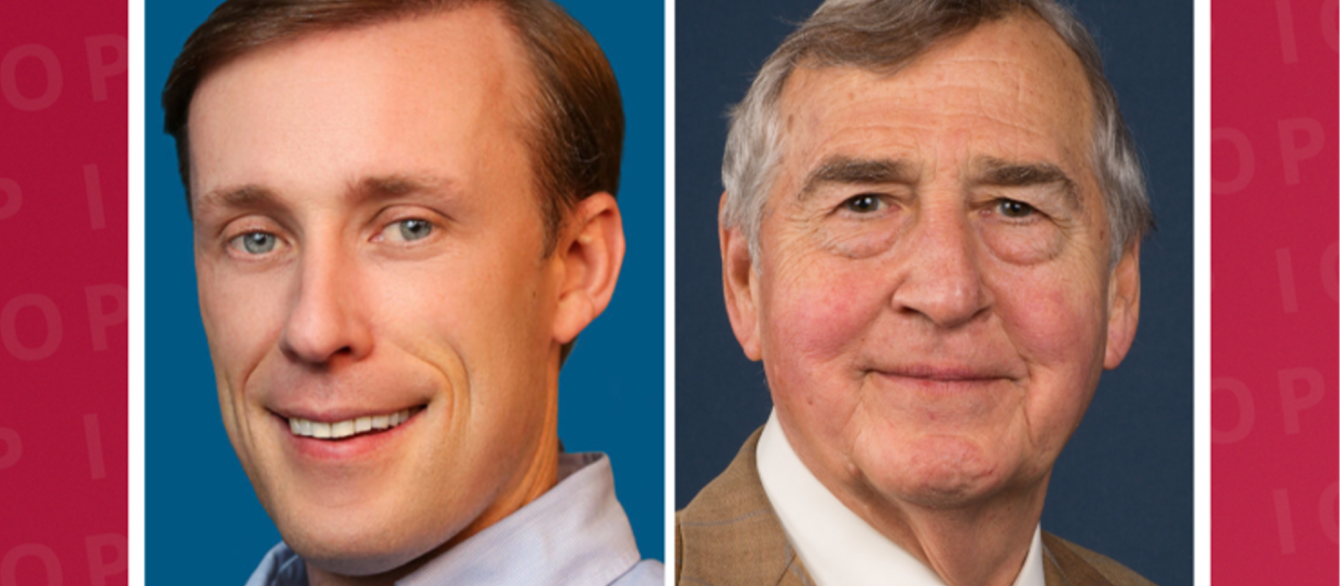This article was originally published by Russia Matters, a Harvard Kennedy School project led by Davis Center associate Simon Saradzhyan.
As President Donald Trump’s administration neared the 100 day mark, former U.S. national security adviser Jake Sullivan, now inaugural Kissinger Professor of the Practice of Statecraft and World Order at Harvard Kennedy School, reflected on the defining challenges of his tenure (2021-2025). In conversation with Graham Allison, the Douglas Dillon Professor of Government at HKS, Sullivan offered a candid account of the Biden administration’s foreign policy decisions, including navigating the fine line between aiding Ukraine in its defense against Russian aggression and averting nuclear catastrophe.
Sullivan emphasized that national security decision-making is rarely black and white. A key dilemma throughout the Ukraine conflict was how to calibrate increased military support without triggering a wider war. “Policy formulation is inherently imperfect,” Sullivan acknowledged, describing the administration’s objective as navigating between two extremes: recklessness — ignoring the risks of nuclear escalation — and excessive caution — failing to act out of fear of triggering World War III. He argued that “if you look at the pattern of choices we made over time, and the results that we generated, […] it was a robust and effective policy that has helped save Ukraine. The main reason Ukraine was saved was the bravery and courage of the Ukrainian people themselves, but the United States played a damn important role alongside many allies and partners in helping to ensure that Russia did not achieve its strategic purpose, which was effectively to wipe Ukraine off the map.”
Fears of nuclear escalation reached a peak during Ukraine’s successful counteroffensive in the Kharkiv and Kherson oblasts in the fall of 2022, a moment CIA director William Burns later described as carrying a genuine risk of Russian tactical nuclear use. While earlier public assessments had avoided assigning probabilities, Sullivan confirmed a previous New York Times report that the CIA had estimated the likelihood of escalation to be as high as 50-50, particularly in the event that Ukrainian forces broke through Russian defensive lines in the easternmost Ukrainian oblasts or advanced into Crimea.
On the question of nuclear escalation in Ukraine, Sullivan unpacked the most common question asked of an administration in the aftermath of a crisis: “What were they thinking?” Sullivan replied that the whole issue of Russia's potential nuclear use was a good example for those interested in a career in policymaking. “I think it's important really for people wanting to pursue a career in public policy to recognize that these decisions are being made with imperfect information, facing imperfect choices, in deep conditions of uncertainty, where how you conceive of both opportunity and risk is simply different when the decision is on your shoulders than it is when you're looking at it either from the outside, or with the benefit of perspective and hindsight,” he said.
Sullivan also touched on the Biden administration’s 2022 decision not to provide Ukraine with Army Tactical Missile System (ATACMS) munitions. Between August and September that year, the Armed Forces of Ukraine initiated two large-scale offensives in the direction of Kherson and Kharkiv respectively, recapturing a total of 5,567 square miles of territory. Ukrainian forces sought to press the advantage by striking Russian positions with long-range fires. ATACMS, capable of hitting targets at a distance of 300 km (186 miles), dramatically outranged Ukraine’s existing GMLRS munitions. Beginning in October 2022, calls to provide Ukraine with ATACMS intensified. The Biden administration resisted for a year, citing concerns about conflict escalation and supply issues, but by September 2023 agreed to provide Ukraine with the missiles. The first strikes took place in October 2023, and further supplies arrived in February 2024.
Sullivan recounted that the decision not to provide ATACMS was taken based on military readiness, not escalation concerns. Then Secretary of Defense Lloyd Austin had indicated to Sullivan that providing the ATACMS requested by Ukraine would render remaining U.S. stocks insufficient for deterring adversaries and home defense. The transfer of ATACMS to Ukraine was enabled only by a successful initiative in 2023 to boost U.S. ATACMS stocks. Sullivan also addressed concerns that these decisions were taken with excessive caution related to fears of Russian nuclear escalation. He pressed on a theme that permeated his address: that U.S. risk calculations had changed significantly since 2022. The battle space of 2022, Sullivan argued, with the front buckling under the Ukrainian advance and Russian forces in headlong retreat, was inherently different to that in 2024. U.S. approaches had changed accordingly, and ATACMS had been provided with permission to fire into Russian territory. Sullivan concluded that, as of now, the U.S. has provided Ukraine with as much of its ATACMS stock as it possibly can, and “has no more to give.”
Sullivan then returned to his earlier comment about policy formation being a compromise within an environment of great uncertainty, underlining that although the Biden administration’s delay in getting weapons to Ukraine was the result of political compromises with a recalcitrant Congress, when the systems finally arrived on the battlefield and were used intelligently by the Ukrainians, there was little evidence that they proved as decisive as critics of the delay asserted.
Asked how he assessed European contributions to the Ukrainian effort, Sullivan steadfastly defended U.S. allies’ records. Collectively, European countries had provided more to Ukraine financially than the U.S., Sullivan argued, as well as stepping up sanctions and production and provision of arms to Ukraine. Sullivan also noted how some European countries, such as Germany, had taken the very difficult decision to curtail reliance on cheap Russian gas, which continues to have political consequences for the governments who decided to do so.
According to Sullivan, the international cooperation, alliances, and stability the present administration rejects constituted the foundations of the world order that the U.S. had created and had benefited from since the end of World War II. These tenets in turn survived the strains of the Cold War. Sullivan called for a world “safe for diversity,” where the U.S. might find a balance between competition and cooperation with its adversaries. It has done so before, he argued, and can do so again.
Opinions expressed herein are solely those of the speakers.
The authors are both graduate student associates with Russia Matters.








